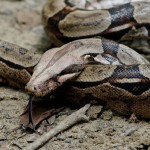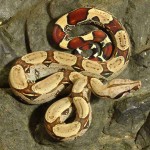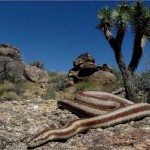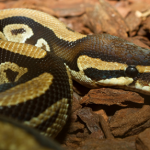Boas and Pythons
Natural history
The group of snakes called “boas” consists of over 40 species. Most popular pet boas are New World species, however boas are also found in Africa and Asia. Most boas live in environments that range from tropical rain forest to dry woodland and scrub forest. Sand boas (Gongylophis spp.) may be found in desert and savannah land and Rosy boas (Lichanura spp.) live in dry, rocky habitats.
Pythons are found in Africa, Australia, and Asia under conditions that range from rain forest to desert. Some species are primarily ground dwellers, but most can be found in bushes and trees. The larger species are often found near water and are strong swimmers.
Pet boas and pythons may be farm-bred, captive-born, or wild-caught imports. Popular companion snakes include the Boa constrictor (Boa constrictor imperator), Rosy boa, and Ball python (Python regius). Ball pythons are docile snakes that coil into a tight ball with the head buried within when frightened. Captive-bred ball pythons are much preferred over wild-caught specimens since the latter can fast for long periods and can be stubborn feeders.
In January 2012, the U.S. government banned the importation of snakes and eggs of four species, Burmese python, northern and southern African pythons, and yellow anacondas, in reaction to the python problem in southern Florida.
[/ezcol_2third_end]
Taxonomy
Class: Reptilia
Order: Squamata
Family: Pythonidae-pythons
Family: Boidae-boas, anacondas
Color and size
| Boa constrictors usually reach 7-8 feet (2 meters) in captivity, but wild specimens may reach more than 12 ft (4 m). | |
| Red-tailed boas (Boa constrictor constrictor) can reach 6-12 ft (2-4 m) | |
| Rosy boas have a blunt tail and smooth scales. The ground color ranges from tan to silver with deep chocolate to orange stripes. Rosy boas are relatively small snakes that rarely exceed 3 ft (0.9 m). | |
| Pythons include some of the world’s largest snakes. Giant snakes like the Burmese python (Python molurus bivitattus) and reticulated python (Python reticulatus) can reach 20 feet (6.1 m) or more and are not recommended for casual hobbyists. However the popular ball python (Python regius) [shown left] rarely exceeds 5 ft (1.5 m) and is usually about 4 ft (1 m) in length. |
Diet
Boas and pythons feed on rodents of appropriate size, primarily mice and rats predominately although gerbils may be preferred by recently imported adult ball pythons. Larger snakes may also be fed rabbits and chickens.
Snakes should be fed every 1-4 weeks depending on the size of the individual. Smaller snakes should be fed more frequently, and larger snakes less frequently. Pre-killed food is preferable since live prey can inflict serious bites and scratches.
Download the client handout: Feeding Snakes for more information.
Husbandry
| Temperature | Provide a daytime temperature gradient of 80-85°F (27-29°C). At night, the temperature may be reduced to 70-75°F (21-24°C). A winter cool-down or “brumation” is important for captive breeding of some species like the rosy boa. |
| Humidity/water | Most (BUT NOT ALL) species do well with a relative humidity of 50-70%.Provide a water bowl large enough for the snake to completely immerse its body, and heavy enough that the animal will not tip it over.Provide ball pythons with a humidity box” or a hiding place filled halfway with damp sphagnum moss. Place the container half on and half off the heat. |
| Cage size | Snakes up to 4 ft (1.2 m) in length can be maintained in at least a 20-gallon (75 L) aquarium or similar sized cage but ideally the habitat should be as long as the snakes. Larger animals need larger cages. For example, breeders often keep ball pythons in cages (or Sterilite tubs) that are 4 ft long. |
| Social structure | Boas and pythons are solitary. |
| Cage furniture |
|
Lifespan
Reported life span ranges:
Common boa constrictor: 20+ years
Ball python: 20+ years
Burmese python: 12-20 years
Red-tailed boa: 20+ years
Rosy boa: 15+ years
Anatomy/ physiology
| Dermatologic: | The scaled skin is normally shed in one piece in a process called “ecdysis”. Snakes lack movable eyelids. Instead a clear scale called the “spectacle”, which is an embryonic fusion of the eyelids, protects the eyes. |
| Cardiopulmonary: |
|
| Gastrointestinal: | The teeth are arranged in six rows with double rows present in the upper jaw. Snake teeth are shed through life, and are attached to the bone’s surface instead of roots. |
| Urogenital: | Snakes possess a renal portal system. Pythons lay eggs (“oviparous”). Boas bear live young, and are “ovoviviparous”. Live young are hatched from eggs within the reproductive tract. |
| Sexual dimorphism: | Both boas and pythons have external or cloacal spurs. These sharp, keratin-covered, bony structures are remnants of the vestigial pelvic girdle. Spurs are better developed in males, and are very small or absent in females. The copulatory organs of the snake are “hemipenes”. Hemipenes lie within pouches at the ventral tail base. Probing of the male pouches will be deeper when compared to females. |
Restraint
- When handling a snake, take care not to smell like snake food (i.e. rodents or rabbits). Wash your hands thoroughly beforehand.
- Support the head, neck, and body. Make sure the body weight is not borne by the snake’s single occipital condyle and the cervical spine.
- A towel is useful for aggressive snakes.
- Never carry a constrictor draped around the neck.
- Another rule of thumb for safety’s sake is to utilize one handler per 3-4 ft (0.9-1.2 m) of snake. Giant constrictors require special precautions to ensure safety of its handlers.
Tail vessel
Cardiac puncture
Injections
Give intramuscular injections between the scales in the epaxial muscles. Use the cranial half of the body to avoid the renal portal system.
Preventive medicine
- Regular physical examination
- Determine gender
- Fecal parasite testing
Important medical conditions
-
- Boid inclusion body disease (IBD) virus
- Dysecdysis, retained spectacles
- Pneumonia
- Stomatitis
**Login to view references**
References
References
Bartlett RD, Bartlett PB, Griswold B, Bartlett RD. Reptiles, Amphibians, and Invertebrates: An Identification and Care Guide, 2nd ed. Hauppage, NY: Barron’s Educational Series; 2010.
De Vosjoli P. The Art of Keeping Snakes. Adv Viv Sys. 2004.
McCurley K. Complete Ball Python, A Comprehensive Guide to Care, Breeding, and Genetic Mutations. ECO/Serpent’s Tale. 2006.
Pollock C. Basic information sheet: Boas and pythons. July 12, 2012. LafeberVet Web site. Available at https://lafeber.com/vet/basic-information-boas-and-pythons/




